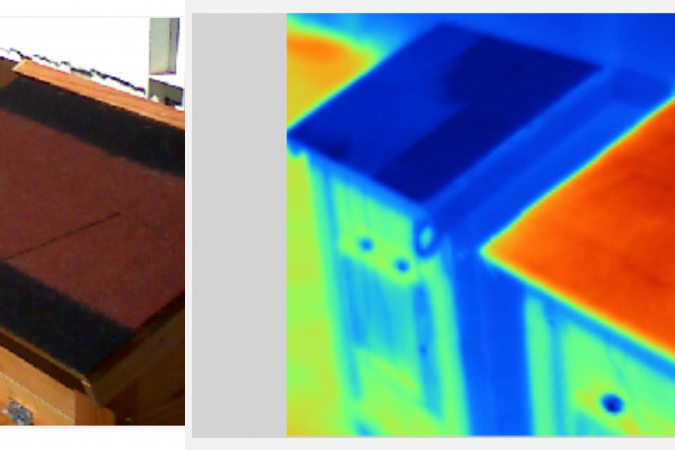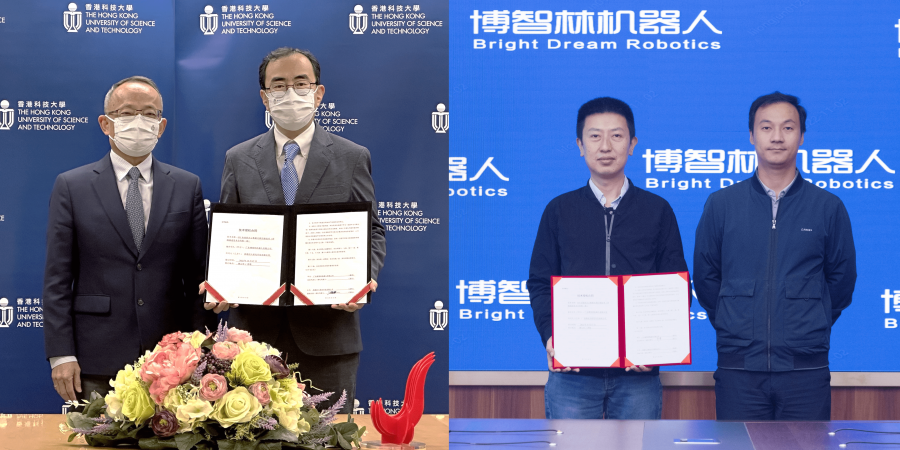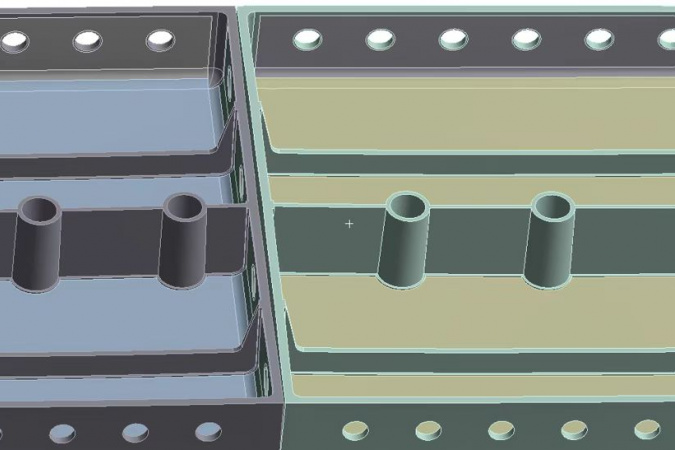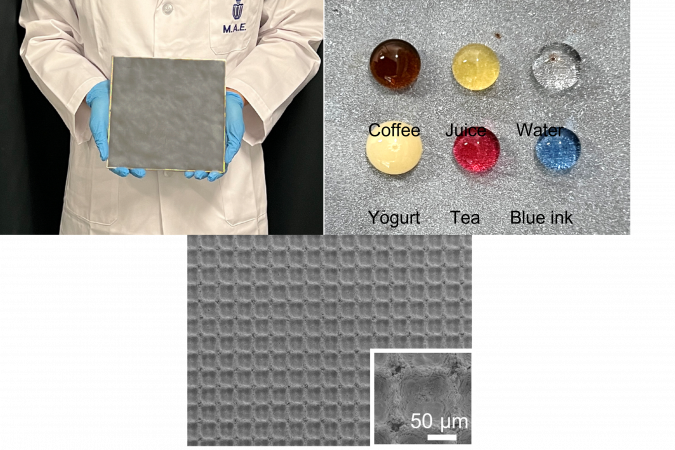HKUST and Bright Dream Robotics Sign Licensing Agreement of Five Technologies
The Hong Kong University of Science and Technology (HKUST) held a signing ceremony with the Guangdong Bright Dream Robotics (BDR) recently to translate five technologies developed by HKUST faculty members into application.
The research achievements – ranging from more efficient building materials to a high-caliber indoor human localization system, are the first batch of scientific outputs from the HKUST-BDR Joint Research Institute (HBJRI) – a joint vehicle of HKUST and BDR to promote innovation and talent grooming.
The licensing agreement of the five discoveries was signed by Dr. Shin Cheul KIM, HKUST Associate Vice-President for Research and Development (Knowledge Transfer), and Mr. LIU Zhen, Vice President and General Manager of Robotics and Intelligent Products Division of BDR, under the witness of Prof. Tim CHENG Kwang-Ting, HKUST Vice-President for Research and Development, and Mr. WANG Kecheng, President of BDR.
Mr. Wang Kecheng, President of BDR, said, “As a market leader in the robotics industry and a tier one company in smart construction, BDR strives to meet the pressing demand for innovation and rapid project development. Our company has been in partnership with HKUST, a top research university, to seize the growing opportunities in the Guangdong-Hong Kong-Macau Greater Bay Area in recent years. Back in February 2019, we already established the HKUST-BDR Joint Research Institute together. The cooperation has built a bridge between academia and industry. The bridge enables research and knowledge transfer, leveraging both parties’ complementary advantages and jointly contributing to the high-quality development of the intelligent construction industry.”
Prof. Tim Cheng, Vice-President for Research and Development at HKUST, said, “Collaboration between academia and the industry is crucial for innovation as well as talent grooming, and fits the Mainland and Hong Kong governments’ agenda in turning the Greater Bay Area into an innovation and technology hub. I am happy to witness the licensing agreement signing today, it exemplifies HKUST’s ability to create something that is impactful for the society. We will continue to forge and deepen our collaboration with the industry to strengthen the University’s endeavors in knowledge transfer.”
Established in 2019, HBJRI is working on nearly 20 projects in areas spanning robotics, AI, smart cities, and big data – most stemmed from real-life challenges met by the industry. HKUST proposed solutions and BDR tested out the ideas in their operations. The five projects which have passed the trial run and will now be officially adopted by BDR are as follows:
1. Development of Inorganic Passive Radiative Cooler for Energy-Efficient Buildings
A new inorganic coating that could help keep buildings cool in hot and humid climates by lowering the temperature by 2-3°C during day time and 6°C at night. The solution-processed coating, which can reflect over 96% of sunlight and emit over 94% of infrared radiation, provides excellent durability, scalability and lower cost compared to similar existing products. This coating can be applied to the external walls of buildings so as to cool down the interior.
2. Research on Design and Forming Technology of Large Composites for Building Formwork and Light-Weight Robots
A systematic simulation methodology and a practical assembly method for designing and manufacturing fiber-reinforced composites based on compression and injection molding process. The techniques developed in this project can be applied to the mold design of fiber-reinforced thermoplastic products, which significantly improve the overall warpage deformation commonly seen in existing products in the market, as well as reduce the number of mold repairs during mold manufacturing and effectively reduce manufacturing costs.
3. GPU-Accelerated Lossless Compression of Point Cloud Data
A parallel compression framework which contains three different compression algorithms to fit different environments and point cloud data. The GPU-accelerated algorithms can be used in large-scale 3D map compression or in real-time autonomous driving systems, and can very well process the point cloud data collected in various complex BDR construction site scene. The compression rate and algorithmic efficiency have reached a high level, laying a solid foundation for the efficient storage and transmission of point cloud data in complex construction site scenarios.
4. Development of Wear-Resistant, Anti-Corrosion, Self-Cleaning, Superhydrophobic Surfaces for Building Robots’ Metal Components
An anti-corrosion and wear-resistant superhydrophobic surface was fabricated by combining scalable laser processing and spray coating methods. This superhydrophobic surface possesses the joint merits of the mechanical strength of stainless steel and the chemical corrosion resistance of PTFE, making it sustainable to harsh environments such as long-term exposure to abrasion, chemicals, thermal, UV, water impact, and seawater immersion. This material can be applied to robots’ metal components to enhance the durability under inhospitable environments.
5. Research and Application on the Integration of Building Information Modeling (BIM) Data and Mobile Map Engine
A technology that allows the transfer of a large amount of BIM data from different locations into a format that can be utilized by the mobile phone, allowing users to accurately and rapidly pinpoint the location of people or facilities inside a building with maps in the mobile. The technology has been deployed and tested in BDR headquarters.
The collaboration also created the pipeline of technologies for BDR’s commercialization. Meanwhile, HKUST will organize the Industry Engagement Day next Monday (November 7) on its Clear Water Bay campus to showcase the University’s research achievements and engage industry partners with HKUST researchers to explore collaboration and technology transfer opportunities. Mr. Wang Kecheng, President of BDR, will be one of the four keynote speakers at the symposium that day. Register now to learn more about the University’s passion and capacity in research and development.
(This news was originally published by the HKUST Public Affairs Office here.)




